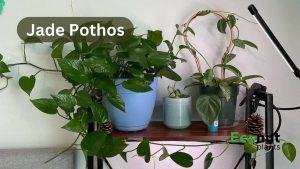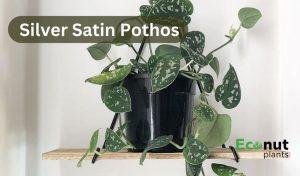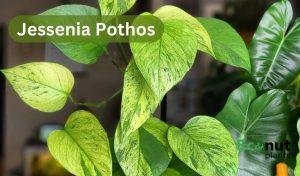Pothos varieties are a stunning addition to any houseplant collection. Pothos species are found all throughout the world, and despite being deadly, they are popular houseplants. These most popular and well-known pothos cultivars cultivated as houseplants are undoubtedly the golden pothos and Epipremnum pinnatum.
The look of pothos is mostly determined by the kind you select. Pothos, commonly known as devil’s ivy, is one of the most popular houseplants, and there are several varieties.
Pothos Plants
The Pothos is without a doubt one of the easiest and most popular houseplants to maintain. These plants flourish inside and can tolerate a wide range of lighting settings. They’re also excellent vining plants, making them ideal for hanging baskets and containers.
Pothos are widely thought to be epiprenum aureum plant types. However, there are numerous additional vining plants known as pothos that are similar in care and appearance and have been included here. The following pothos cultivars are enjoyable to produce and show in your home.
Know more: Pothos Plant: An Ideal Houseplant For Brightening Any Room
Pothos Varieties
Here are some incredible pothos kinds you may grow at home. The term pothos, like many common names, is used relatively loosely, but it mainly refers to plants of the Epipremnum genus, particularly the Aureum species. Let’s have a look at some lovely pothos variants.
Top 18 Pothos Varieties
1. Golden Pothos
 Botanical name: Epipremnum aureum
Botanical name: Epipremnum aureum
Sun Exposure: Indirect sunlight
Leaf Size: 6-24 inches long
Golden Pothos is the original pothos that may be found in every nursery worldwide. It is an absolute must-have for every indoor gardener as the authentic Epipremnum aureum. It is the most common and versatile of all pothos plants, making it perfect for both novice and professional gardeners.
Although it is the most common, it is no less attractive than its cultivars. The heart-shaped leaves are dotted with splashes of creamy and golden yellow. The vines spread swiftly, creeping over bookcases and across tables.
2. Neon Pothos

Botanical name: Epipremnum aureum ‘Neon’
Sun Exposure: direct sunlight
Leaf Size: 6-12 inches long
Among pothos variations, neon pothos has a “medal”: it has the most exquisite heart shaped leaves of all. In reality, it derives from a hue, neon green, which is the gleaming green of early neon lights. Since the leaves of this kind of pothos are the most vivid green you’ve ever seen.
Actually, they begin a little lighter and eventually turn beautiful neon green. As a monochromatic type, neon pothos surely makes the best of both form and colour, which may explain why it is so popular.
3. Marble Queen Pothos

Botanical name: Epipremnum aureum ‘Marble Queen’
Sun Exposure: Indirect sunlight
Leaf Size: 15 inches
Marble Queen Pothos is a popular variegated variety and a sought-after collector’s item. It is not difficult to locate or care for because it is one of the early cultivars.
The Marble Queen’s Pothos design is similar to that of the Golden Pothos. The hue of the variegation, on the other hand, distinguishes it. This cultivar has dazzling white specks that flow perfectly into the green to make a color patchwork. The leaves certainly resemble marbling, especially in heavily variegated plants, as the name suggests.
The colour may vary according on the lighting, giving you an ever-changing plant that is sure to stun. Some leaves may be almost entirely white, entirely green, or a good balance of the two.
4. Jade Pothos

Botanical name: pipremnum aureum ‘Jade’
Sun Exposure: Bright, indirect light
Leaf Size: 3 inches
The original is jade Pothos. This plant has medium-sized solid green leaves with a tidy growing habit. However, because it is a bit plain, it has been mainly displaced by more pleasing looking pothos cultivars.
There are several varieties, only a few popular cultivars are offered in typical plant stores nowadays. They all require the same maintenance but are more appealing owing to their unique and appealing leaf markings.
5. Cebu Blue Pothos

Botanical name: Epipremnum pinnatum ‘Cebu Blue’
Sun Exposure: Bright, indirect light
Leaf Size: 11cm
Cebu blue is a rare variety of Pothos epipremanum aureum, and it’s my favourite. If you’re wondering why, it lacks the distinctive heart-shaped leaves of pothos. Cebu Blue Pothos, on the other hand, has arrow-shaped blue-green leaves. Additionally, these leaves usually have a subtle blue-metallic sheen, which distinguishes them from other varieties.
The small leaves are usually arrow-shaped, however if the Cebu Blue Pothos is given enough light, the leaves will expand and produce a natural division! However, they take time to grow, so you must be patient.
6. Dragon’s Tail Pothos

Botanical name: Epipremnum pinnatum ‘Dragon’s Tail’
Sun Exposure: Bright, indirect light
Leaf Size: 80 mm x 42 mm wide
The Tail of the Dragon Pothos also goes by the names Dragon-Tail Plant, Taro Vine, and Silver Vine. It is a lovely climbing plant known for its thick evergreen vine. This plant looks fantastic in a hanging basket and makes an excellent houseplant.
It is a member of the Araceae family. This perennial has glossy green mature leaves that are commonly bovate, elliptical, or oblong. It, like other indoor plants, prefers dampness, making it an excellent choice for a kitchen, bathroom, or balcony. If you live in hardiness zones 10-12, you may also grow your Dragon’s Tail Pothos outside.
7. Baltic Blue Pothos

Botanical name: Epipremnum pinnatum ‘Baltic Blue’
Sun Exposure: indirect light
Leaf Size: 6-12 inches long
The Baltic blue pothos is a clone of the dragon tail pothos, Epipremnum pinnatum. It differs from the Cebu blue and dragon tail pothos by having dark green foliage with a blue undertone. It also has bigger leaves and develops fenestrations earlier than Cebu blue pothos.
The Baltic Blue Pothos looks like the Cebu Blue Pothos. This indoor vine requires very little care; just water it when the soil is dry and give it plenty of bright indirect sunshine. When you detect new leaves growing, don’t forget to fertilize this vigorous grower! Staking your Epipremnum pinnatum may aid in the development of lobes and the growth of bigger leaves.
8. Global Green Pothos

Botanical name: Epipremnum aureum ‘Global Green’
Sun Exposure: bright, indirect light
Leaf Size: 3 to 6 inches long
Global Green and Emerald Green are two newer varieties that hit the general market around 2020. Both are considered “strange,” but if you stumble across one, neither should be prohibitively expensive given to their ease of cultivation and rapid growth.
Propagation has a high success rate, and plants develop swiftly after they are established after a few months. As a result, major vendors and nurseries can mass-produce new plants quickly.
Although two different colours, Global Green is all green. Global Green Pothos is a soft shade of green on the inside and dark green on the outside. It has characteristics of both neon and native jade. However, the leaves are more tightly packed and smaller.
9. N’Joy Pothos

Botanical name: Epipremnum aureum ‘N’Joy’
Sun Exposure: low to bright indirect light
Leaf Size: 2” long
It is also recognized and branded as Pearls and Jade. N’Joy Pothos has a beautiful growth habit and looks great draped and hanging down from a shelf or window sill. The leaves are green, but blotched throughout with slightly off white parts. Adding contrast and improving the plant’s attractiveness.
It’s worth noting that this plant isn’t the quickest growing and is less tolerant of insufficient watering. If you allow it dry out too much, it will droop and seem sickly, indicating that it is unhappy. On the bright side, it’s the simplest variety to reproduce in tiny jars or containers using only water.
10. Pearls and Jade Pothos

Botanical name: Epipremnum aureum ‘Pearls and Jade’
Sun Exposure: indirect and bright light
Leaf Size: 4–5 cm
One of the most exquisite forms of this houseplant is the pearls and jade pothos. In reality, it has the grace of butterfly wings or a silk scarf flapping in the breeze. The variation of the many tones of green and milky white provides an oriental feel to it. The images they paint on the leaves have the appearance of watercolours, with seamless transitions.
Each leaf has only one big green region in the middle, one white area around it, and sometimes some little green lines around the borders. However, the green, particularly on the jade tone, ranges from very brilliant to strong and dark.
11. Glacier Pothos
 Botanical name: Epipremnum aureum ‘Glacier’
Botanical name: Epipremnum aureum ‘Glacier’
Sun Exposure: indirect and bright light
Leaf Size: Small
Glacier pothos is a variegated form of this plant. Because of its unique characteristics, this cultivar is becoming increasingly popular in garden centers. To begin with, it has a somewhat compact habit. Because of this, as well as its tiny size, it is suitable for coffee tables and office workstations.
The most stunning characteristic of this pothos is the colour pattern on the leaves! They feature wide, soft-looking areas of cream white and emerald green that are nicely defined. On the leaves, these create incredibly attractive and even sculptural shadows.
12. Manjula Pothos

Botanical name: Epipremnum aureum ‘Manjula’
Sun Exposure: bright, indirect light
Leaf Size: Medium
This is a cultivar (developed in 2010 by Indian scientists), a cross between N’Joy and the Jade. It has similar green and contrasting white variegation in the leaves to the N’Joy, but larger leaves, and wavy edges that give it an unusual appearance.
It grows relatively quickly and looks great in a container, hanging basket, or climbing a support pole. The biggest disadvantage is that because it is a cultivar, there is strict restriction on who may cultivate and sell these plants. This indicates it may be more uncommon and expensive than the majority of the other items on this list.
13. Silver Satin Pothos

Botanical name: Scindapsus pictus ‘Exotica’
Sun Exposure: Direct light
Leaf Size: 6-8 inches long
Satin pothos, also known as silver pothos, brings the pothos table’s guest list to a close. This vine is stunning in a variety of ways. To begin with, unlike “real” pothos plants, it will occasionally flower. And the bloom is rather unique in appearance. In reality, it resembles a white pinecone or an unusual tropical fruit.
Then there’s the greenery that clings to the trailing branches. It’s a dull green with lighter green specks all over it. Actually, the result is rather attractive. It resembles the dappled light seen from beneath the canopy of tropical jungles. And the distinctive Pothos plant completes the eye-catching exotic appeal.
14. Satin Pothos

Botanical name: Scindapsus pictus ‘Argyraeus’
Sun Exposure: bright light but be indirect
Leaf Size: 8 inches
The Scindapsus pictus ‘Argyraeus,’ often known as the satin pothos, is technically not a pothos because it is not a member of the Epipremnum genus, but its look and care are comparable, so it is worth adding here. It has tiny, shimmering green and silver leaves and a vining growth habit.
Satin pothos is an easy-care houseplant. In addition to basic maintenance such as watering and fertilizing, you may improve its look by snipping off any damaged or dead leaves and trimming when the vines get too long and sparse. If the leaves of your satin pothos become dusty, you may wash them with water. Oil should not be used to make them shine since it can clog the cells and impair the leaves’ capacity to breathe.
15. Jessenia Pothos

Botanical name: Epipremnum aureum ‘Jessenia’
Sun Exposure: bright, indirect light
Leaf Size: 14 cm long
Jessenia pothos has heart-shaped light green leaves studded with greenish-yellow colours. Every leaf of Jessenia pothos will be distinct from the others, much as Marble Queen. Due to a lack of chlorophyll, Jessenia grows more slowly than non-variegated pothos.
Marble Queen and Jessenia are easily distinguished because the limey-green variegation of Jessenia is considerably darker than the brighter, whiter variegation of Marble Queen.
16. Variegated Neon Pothos

Botanical name: Epipremnum aureum ‘Neon Variegata’
Sun Exposure: bright, indirect light
Leaf Size: Medium
Variegated Neon Pothos plants have bright yellow leaves and are relatively easy to care for; they will add colour to your indoor plant garden. Because of its distinctive look and texture, this common houseplant is popular among plant collectors.
While spots of tiny variegation are usual on a conventional neon pothos, the variegated neon pothos is differentiated by consistent variegation of vivid green/yellow throughout its leaves. Its variegation will begin to revert under low light circumstances, so a site that gets strong, indirect light is preferable for this pothos.
17. Harlequin Pothos

Botanical name: Epipremnum aureum ‘Harlequin’
Sun Exposure: Partial shade
Leaf Size: Medium
The harlequin pothos is without a doubt the rarest pothos available, with beautifully variegated white and dark green leaves. It resembles the Manjula pothos in appearance, but it lacks the cream or yellow coloration. It needs strong, indirect light to sustain its vibrant variegation.
Harlequin pothos is a popular houseplant due to its ease of maintenance. In fact, it is frequently advised to novices interested in plant care. The plant can withstand a broad range of environments, making it excellent for individuals with little expertise with plants.
18. Snow Queen Pothos

Botanical name: Epipremnum aureum ‘Snow Queen’
Sun Exposure: Bright, indirect light
Leaf Size: Medium
Variegation enthusiasts who already own one Marble Queen will fall in love with the Snow Queen cultivar. It has the largest colour variation of any plant on this list, with big white spots covering every leaf. The leaves of certain plants seem more white than green, with only a few speckles indicating that the plant has any green at all.
It’s no surprise that it was given the cultivar name ‘Snow Queen.’ The only disadvantage of this unique plant is the extra care required to keep it healthy and happy. These leaves have significantly less chlorophyll than typical because to the big white variegation markings. The plant processes less sunlight and develops more slowly when it has less chlorophyll.
If you are searching fresh and live houseplants online then checkout our extensive collection of amazing indoor and outdoor houseplants.
I hope you enjoyed reading the Pothos Varieties Guide. If you think we have forgotten something or have a suggestion, please leave it in the comment section below.

